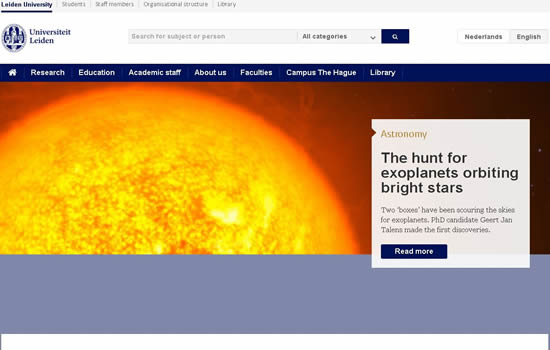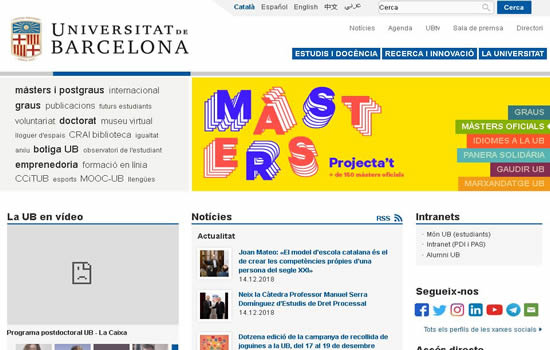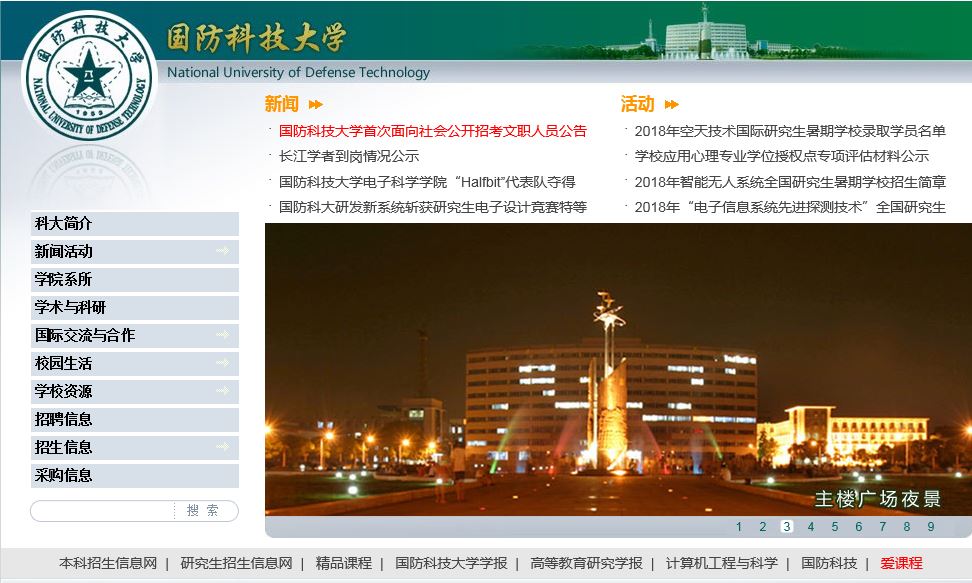选择热点
 荷兰莱顿大学
荷兰莱顿大学 西班牙巴塞罗那大学
西班牙巴塞罗那大学 巴西圣保罗大学 University of Sao Paulo, Brazil
巴西圣保罗大学 University of Sao Paulo, Brazil 台湾南华大学 University of South China in Taiwan
台湾南华大学 University of South China in Taiwan 科技大学 National University of Defense Technology
科技大学 National University of Defense Technology 南京大学 Nanjing University
南京大学 Nanjing University 上海复旦大学 Fudan University
上海复旦大学 Fudan University 泗水大学(Ubaya)
泗水大学(Ubaya) 印尼大学 universitas indonesia
印尼大学 universitas indonesia 越南某大学 Vietnam National University
越南某大学 Vietnam National University 菲律宾大学 University Of The Philippines
菲律宾大学 University Of The Philippines
经典译文之散文欣赏:无名海欣赏
发布时间:2025-01-06
来源:大学网站
from wiring tectonic plates to collecting deep underwater rocks to sending a lunar lander-like probe to the ocean floor, scientists are probing the final frontier of the ocean.
this vast region, which harbors some of the most exotic life forms on the planet, has been long neglected, but that's changing.
scientists are turning to high technology to probe the mysterious land beneath the seas, and within a few years the textbooks will have to be rewritten.
we'll see critters that we've never seen before and learn more about the dynamic forces that drive the planet.
wiring an entire tectonic plate many projects that are now in advanced planning stages couldn't have been done just a few years ago.
consider this: scientists from a wide range of research institutions are planning to "wire" an entire tectonic plate off the coast of the pacific northwest and british columbia.
the juan de fuca plate is smaller than most tectonic plates, the huge chunks of the earth's crust that move slowly about the planet.
but its subduction under the north american continental plate causes earthquakes and volcanoes along much of the pacific northwest.
an undersea robot that operates somewhat like the lunar lander that carried astronauts to the surface of the moon is being used to study the impact of oil drilling operations on the floor of the gulf of mexico.
the u.
s.
coast guard's newest icebreaker is on its maiden voyage, and its first challenge is a dandy.
the 420-foot healy will follow the famed northwest passage through the arctic ocean while attempting to collect rock samples from the ocean floor.
these and other research projects, including the 10-year, $1 billion international effort to inventory the critters that live in the world's oceans, called the census of marine life, and the effort to study the entire mid-atlantic ridge, an underwater mountain range where new crust is being formed, are ambitious projects that will take years to complete.
indeed, the scientists behind the plans to study the juan de fuca plate believe the sophisticated network of sensors and fiber optic cables they will be laying off the pacific northwest will still be in use 30 or 40 years from now.
project neptune is expected to cost about $200 million.
determing how organisms survive about 2,000 miles of fiber optic cables will be strung across the 80,000-square-mile juan de fuca plate, according to john delaney, a university of washington oceanographer who heads a consortium of neptune participants from the university, monterey bay research institute, nasa's jet propulsion lab, canada's institute for pacific ocean science and technology, and woods hole oceanographic institution.
the cables will provide electric power and communications to sensors spread all over the plate, which is bigger than the state of washington, as well as about 70,000 square miles of ocean bottom surrounding the plate.
tiny subs will zip back and forth between about 30 sites more than a mile under the surface where experiments can be conducted.
the experiments will seek to determine how some organisms survive without sunlight under intense pressures, and even in environments that would poison nearly all other forms of life.
this part of the project got a boost recently with a $5 million grant from the w.
m.
keck foundation of los angeles.
project neptune will allow scientists to study the dynamic processes that drive plate tectonics, and the rest of us have been invited along for the ride.
the data, including images, will be available to anyone via the internet once the project is operational in four or five years.
delaney says he wants it to be like a public "oceanarium.
" "oceans are the most fascinating feature of our solar system," he says.
"we want everyone with a home computer to be able to access what we're studying and eventually involve schoolchildren in our robotic operations, allowing them to experience firsthand the mysteries of the deep.
" texans discovering what drilling is doing meanwhile, deep in the heart of texas, scientists want to know more than just what the ocean is like.
they want to know what we're doing to it.
so a consortium of universities, led by texas a&m, is using a 10-foot-tall, 1-ton robotic device to study the deeper regions of the gulf of mexico before oil drilling begins there.
【经典译文之散文欣赏:无名海欣赏查看网站:[db:时间]】
this vast region, which harbors some of the most exotic life forms on the planet, has been long neglected, but that's changing.
scientists are turning to high technology to probe the mysterious land beneath the seas, and within a few years the textbooks will have to be rewritten.
we'll see critters that we've never seen before and learn more about the dynamic forces that drive the planet.
wiring an entire tectonic plate many projects that are now in advanced planning stages couldn't have been done just a few years ago.
consider this: scientists from a wide range of research institutions are planning to "wire" an entire tectonic plate off the coast of the pacific northwest and british columbia.
the juan de fuca plate is smaller than most tectonic plates, the huge chunks of the earth's crust that move slowly about the planet.
but its subduction under the north american continental plate causes earthquakes and volcanoes along much of the pacific northwest.
an undersea robot that operates somewhat like the lunar lander that carried astronauts to the surface of the moon is being used to study the impact of oil drilling operations on the floor of the gulf of mexico.
the u.
s.
coast guard's newest icebreaker is on its maiden voyage, and its first challenge is a dandy.
the 420-foot healy will follow the famed northwest passage through the arctic ocean while attempting to collect rock samples from the ocean floor.
these and other research projects, including the 10-year, $1 billion international effort to inventory the critters that live in the world's oceans, called the census of marine life, and the effort to study the entire mid-atlantic ridge, an underwater mountain range where new crust is being formed, are ambitious projects that will take years to complete.
indeed, the scientists behind the plans to study the juan de fuca plate believe the sophisticated network of sensors and fiber optic cables they will be laying off the pacific northwest will still be in use 30 or 40 years from now.
project neptune is expected to cost about $200 million.
determing how organisms survive about 2,000 miles of fiber optic cables will be strung across the 80,000-square-mile juan de fuca plate, according to john delaney, a university of washington oceanographer who heads a consortium of neptune participants from the university, monterey bay research institute, nasa's jet propulsion lab, canada's institute for pacific ocean science and technology, and woods hole oceanographic institution.
the cables will provide electric power and communications to sensors spread all over the plate, which is bigger than the state of washington, as well as about 70,000 square miles of ocean bottom surrounding the plate.
tiny subs will zip back and forth between about 30 sites more than a mile under the surface where experiments can be conducted.
the experiments will seek to determine how some organisms survive without sunlight under intense pressures, and even in environments that would poison nearly all other forms of life.
this part of the project got a boost recently with a $5 million grant from the w.
m.
keck foundation of los angeles.
project neptune will allow scientists to study the dynamic processes that drive plate tectonics, and the rest of us have been invited along for the ride.
the data, including images, will be available to anyone via the internet once the project is operational in four or five years.
delaney says he wants it to be like a public "oceanarium.
" "oceans are the most fascinating feature of our solar system," he says.
"we want everyone with a home computer to be able to access what we're studying and eventually involve schoolchildren in our robotic operations, allowing them to experience firsthand the mysteries of the deep.
" texans discovering what drilling is doing meanwhile, deep in the heart of texas, scientists want to know more than just what the ocean is like.
they want to know what we're doing to it.
so a consortium of universities, led by texas a&m, is using a 10-foot-tall, 1-ton robotic device to study the deeper regions of the gulf of mexico before oil drilling begins there.
【经典译文之散文欣赏:无名海欣赏查看网站:[db:时间]】
- 上一篇: From Song Of Myself
- 下一篇: 多留心,多付出,获得意想不到的收获
相关阅读
目录列表
资讯列表
英语资讯


共0条评论
网友评论温馨提示:您的评论需要经过审核才能显示,请文明发言!